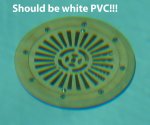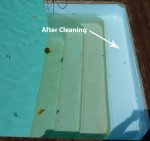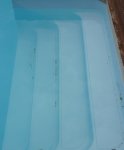Hi all, new to this forum. I'm located in France and need some help with a pool with a vinyl liner that has turned brown. I think, but can't be 100% sure that the stains occured when I was welding and grinding a few days ago and think that the iron grindings have probably blown in to the pool with the wind.
All the white PVC fittings, the liner and the fibreglass steps have turned brown and shock chlorine and scrubbing has done nothing.
I lowered the water level and managed to clean the top step and the skimmers and return jets plus about 10" of the liner above the water using a liner cleaner which I think was a 5% solution of Sodium Hydroxide (Caustic Soda).
I tried adding Vitamin C tablets on to the 2nd step below the water line and 4 tablets removed a fairly large area of the brown stain in a few minutes so I assume that it is Iron stains rather than organic staining.
I have been searching the internet for solutions and it seems that either Oxalic Acid or Ascorbic Acid will work since the Vitamin C tablets worked so quickly.
I am going to have to go with the Oxalic Acid as this is readily available and about a 1/5th of the price of the Ascorbic Acid in France. 80 Euros for 25Kg compared to 550 Euros for 25kg of Ascoric Acid.
What I need is a step by step guide to using the Oxalic Acid as I am not sure exactly how much to addm how to remove it from the pool after the stains are removed, what else I need to add, to run the filter or not, pH levelsm etc etc.
I think from what I have read on the net that this might be the steps required but need confirmation please.
1. Lower Chlorine levels to 0ppm
2. Raise pH to 6.8
3. Add 0.95Kg of Oxalic Acid for 75000 Liters of water.
4. Pour the acid in around the edges of the pool
5. Switch filter to circulation and leave to run for a few hours
6. When stains are removed add a additive to remove the metal compounds from the water
7. Increase the pH to 7.2 using what we call here "pH+" or "pH plus" (I have an automatic pH doser to do this)
8. Increase the chlorine level back to 1-3ppm
9. Check chlorine and pH daily and adjust as necessary
10. Keep the pH around 7.2 for 2 weeks then increase back to 7.3 - 7.4
How am i doing, does this sound about right or have I missed anything?
Would appreciate any help. Oh, if you mention any products etc by name etc can you specify what they actually do and are used for as the terms and names you use in the US do not really match up to here in France and the UK.
Thank for the help, looking forward to the replies.
Rob.
All the white PVC fittings, the liner and the fibreglass steps have turned brown and shock chlorine and scrubbing has done nothing.
I lowered the water level and managed to clean the top step and the skimmers and return jets plus about 10" of the liner above the water using a liner cleaner which I think was a 5% solution of Sodium Hydroxide (Caustic Soda).
I tried adding Vitamin C tablets on to the 2nd step below the water line and 4 tablets removed a fairly large area of the brown stain in a few minutes so I assume that it is Iron stains rather than organic staining.
I have been searching the internet for solutions and it seems that either Oxalic Acid or Ascorbic Acid will work since the Vitamin C tablets worked so quickly.
I am going to have to go with the Oxalic Acid as this is readily available and about a 1/5th of the price of the Ascorbic Acid in France. 80 Euros for 25Kg compared to 550 Euros for 25kg of Ascoric Acid.
What I need is a step by step guide to using the Oxalic Acid as I am not sure exactly how much to addm how to remove it from the pool after the stains are removed, what else I need to add, to run the filter or not, pH levelsm etc etc.
I think from what I have read on the net that this might be the steps required but need confirmation please.
1. Lower Chlorine levels to 0ppm
2. Raise pH to 6.8
3. Add 0.95Kg of Oxalic Acid for 75000 Liters of water.
4. Pour the acid in around the edges of the pool
5. Switch filter to circulation and leave to run for a few hours
6. When stains are removed add a additive to remove the metal compounds from the water
7. Increase the pH to 7.2 using what we call here "pH+" or "pH plus" (I have an automatic pH doser to do this)
8. Increase the chlorine level back to 1-3ppm
9. Check chlorine and pH daily and adjust as necessary
10. Keep the pH around 7.2 for 2 weeks then increase back to 7.3 - 7.4
How am i doing, does this sound about right or have I missed anything?
Would appreciate any help. Oh, if you mention any products etc by name etc can you specify what they actually do and are used for as the terms and names you use in the US do not really match up to here in France and the UK.
Thank for the help, looking forward to the replies.
Rob.





